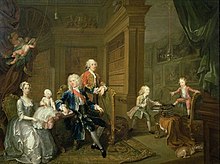George Cholmondeley, 3rd Earl of Cholmondeley
Appearance
George Cholmondeley | |
|---|---|
 The Cholmondeley Family, William Hogarth (1732) | |
| Member of the British House of Commons | |
| In office 1724–1733 | |
| Preceded by | John Smith |
| Succeeded by | Sidney Beauclerk |
| Constituency | |
| Personal details | |
| Born | 2 January 1703 |
| Died | 10 June 1770 (aged 67) |
| Spouse |
Lady Mary Walpole (m. 1723) |
| Children | George, Viscount Malpas and Robert |
| Parent(s) | George Cholmondeley, 2nd Earl of Cholmondeley Elizabeth van Ruyterburgh |
| Military service | |
| Allegiance | Great Britain |
| Years of service | 1733–1760 |
George Cholmondeley, 3rd Earl of Cholmondeley, House of Commons from 1724 to 1733.
Life
Cholmondeley was the son of
Privy Council.[1]
Horace Walpole described him as "a vain and empty man, shoved up so high by his father-in-law, Sir Robert Walpole, and fallen into contempt and obscurity by his own extravagance and insufficiency."[2]
Apart from his political career, Lord Cholmondeley was also
Lord Lieutenant of Cheshire and South Wales (less Denbighshire) from 1733 to 1760. He was promoted to colonel in 1745, major-general in 1755, and lieutenant-general in 1759. He was also involved in the charitable effort to create a home for foundlings in London, which was hoped would alleviate the problem of child abandonment. The home became known as the Foundling Hospital
and Cholmondeley sat on its board as a founding Governor.
Private life
Lord Cholmondeley married Lady Mary Walpole, daughter of Prime Minister
Robert Walpole, 1st Earl of Orford, in 1723. He died on 10 June 1770, aged 67. His eldest son George Cholmondeley, Viscount Malpas, predeceased him and he was succeeded in his titles by his grandson George, who was created Marquess of Cholmondeley in 1815. His second son Robert (1727–1804) began his career as a lieutenant in the 3rd Foot Guards but resigned after the Battle of Lauffeld in July 1747 and became a minister.[3] Robert was married to the socialite Mary Woffington.[4]
The actress Maria Nossiter was the daughter of Lord Cholmondeley's "favourite" housekeeper. Maria was educated, had money and enjoyed a successful, but brief, career. It is supposed that she was his daughter.[5]
References
- ^ "CHOLMONDELEY, Hon. George (1703-70)". History of Parliament Online. Retrieved 26 April 2019.
- ^ "Cholmondeley family". Elisa Rolle. Retrieved 17 May 2019.
- ISBN 978-0140436501.)
{{cite book}}: CS1 maint: location (link - ISBN 978-0-8093-1803-2.
- doi:10.1093/ref:odnb/64355. Retrieved 2 November 2020. (Subscription or UK public library membershiprequired.)
